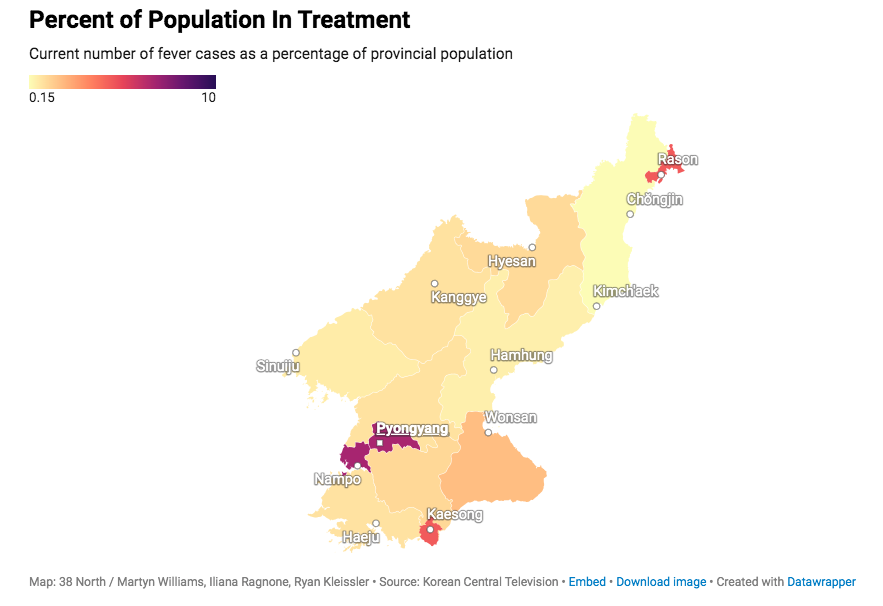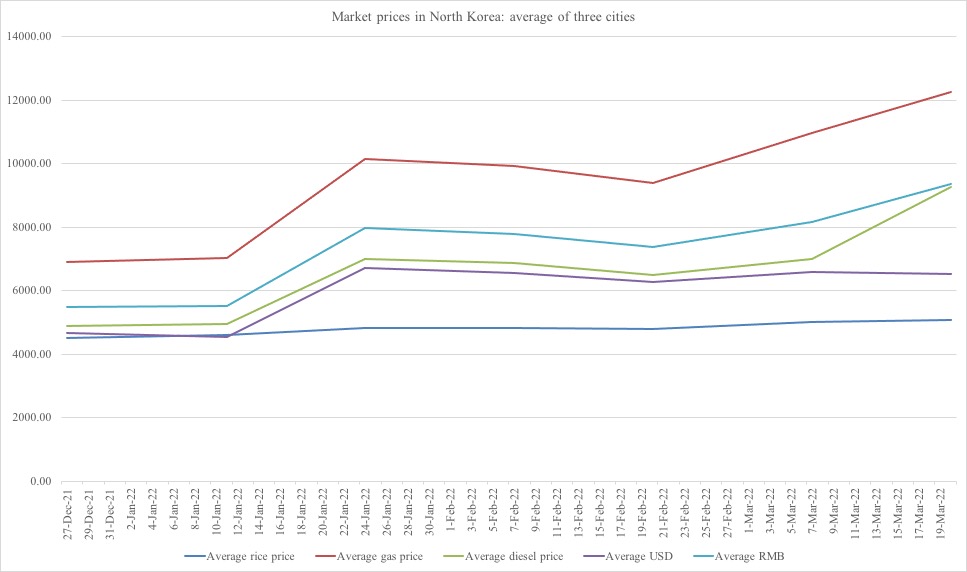By: Benjamin Katzeff Silberstein
Since last month, there’s been strong signs that North Korea may soon declare “victory” over Covid-19. Its claims of progress against the virus are puzzling, like many claims the country has made about its Covid-19 situation, especially at a time when cases were climbing in the rest of the region. The most recent example came this past Monday, when the regime said it was close to solving the crisis completely:
“The anti-epidemic campaign is improved to finally defuse the crisis completely,” the Korean Central News Agency said. It added that the North had reported 310 more people with fever symptoms.
The World Health Organization has cast doubts on North Korea’s claims, saying last month it believed the situation was getting worse, not better, amid an absence of independent data.
The North’s declaration could be a prelude to restoring trade long hampered by the pandemic, one analyst said.
“Under the current trend, North Korea could announce in less than a month that its COVID crisis is over and that could be a prelude to resuming crossborder trade,” said Cheong Seong-chang, director of the Sejong Institute’s North Korea studies centre in South Korea.
(Source: Reuters, “North Korea says nearing end of COVID crisis,” Reuters, 18/7/2022.)
Signs that North Korea may soon declare victory began to appear only a little over a month after the country even admitted to having any cases of the virus in the first place. As AP put it a few weeks ago:
According to state media, North Korea has avoided the mass deaths many expected in a nation with one of the world’s worst health care systems, little or no access to vaccines, and what outsiders see as a long record of ignoring the suffering of its people.
[…]
What’s clear, though, is that the daily updates from state media make it appear inevitable that the nation will completely defeat a virus that has killed more than 6 million people around the world. According to the official tally, cases are plummeting, and, while 18% of the nation of 26 million people reportedly have had symptoms that outsiders strongly suspect were from COVID-19, less than 100 have died.
The South Korean government as well as some experts believe that North Korea may soon declare that it has beaten the virus. This will be linked, of course, to Kim’s strong and clever guidance.
[…]
“There are two sides to such a declaration,” said Moon Seong Mook, an analyst with the Seoul-based Korea Research Institute for National Strategy. “If North Korea says that COVID-19 has gone, it can emphasize that Kim Jong Un is a great leader who has overcome the pandemic. But in doing so, it can’t maintain the powerful restrictions that it uses to control its people in the name of containing COVID-19.”
(Source: Hyung-jin Kim, “‘It always wins’; North Korea may declare COVID-19 victory,” Associated Press, 21/6/2022.)
Indeed, a declaration of final victory is by no means a certainty, and the government would indeed lose a powerful reason for the stronger measures of social control it has implemented over the past few years.
But what about all the state has to win by declaring victory over Covid-19? I’m not talking here about the propaganda value for Kim Jong-un and his “clever guidance”, but about the economy. I speculated when the North Korean government first admitted that Covid had spread to the country that it could be a step toward normalizing the situation and, in the longer run, a step toward opening the border back up for trade with China.
When the government recognized it had been hit by Covid, it turned it from a risk to be avoided at all cost into a problem to be dealt with. By doing so, it made the border closure more or less superfluous; if the virus is already in the country, no more need to keep trade at close to a standstill.
In this light, declaring victory over the virus would be a natural step, and that would itself be a step toward fully normalizing trade and easing or abolishing internal restrictions. Several recent signs indicate that this may be happening. North Korea seems to, more or less, want to open trade back up with China, no longer fearing that the virus will enter the country. To the contrary, Chinese authorities are now weary of the virus coming in from North Korea. As Daily NK reports:
Although North Korea is making a show of confidence, claiming that the coronavirus situation in the country has “completely stabilized,” the Chinese government is tightly controlling trade with the North due to concern about the state of the pandemic in the country.
According to a Daily NK source in China on Monday, as coronavirus cases decrease, factories and restaurants are reopening in regions of China that border North Korea, including Liaoning and Jilin provinces. With highways, railways, ports and other inter-regional transportation links soon set to reopen as normal, the movement of goods and people within China is expected to improve.
However, in contrast to moves to relax domestic disease control measures, the Chinese government has yet to begin easing controls and inspections regarding trade with North Korea. In regions that border North Korea, Chinese authorities are reportedly cracking down hard on Chinese people directly contacting or doing business with North Koreans.
The source told Daily NK that the Chinese government is levying fines of at least RMB 300,000 (around USD 44,450) on people caught smuggling with North Koreans, a measure that has helped prevent Chinese traders from readily dealing with their North Korean counterparts.
On the other hand, North Korean trade officials are making more requests for imports from Chinese traders. With North Korean authorities recently allowing certain North Korean trading companies to participate in or expand existing trade with China, these companies appear to be responding by increasingly asking for items to import.
(Source: Seulkee Jang, “China still appears wary about reopening trade with North Korea,” Daily NK, 20/7/2022.)
North Korean firms, presumably on order by or at least approval from the state, are in other words trying to start trade ties back up while Chinese authorities are weary.
Internally, too, authorities have eased restrictions. According to Radio Free Asia, travel restrictions were virtually dismantled late last month:
North Korea has lifted COVID-19 travel restrictions nationwide, a sign the government may soon claim victory over the coronavirus pandemic, RFA has learned.
After two years of denying the virus had penetrated its closed borders, North Korea in May acknowledged COVID had begun to spread among participants of a large-scale military parade the previous month and declared a “maximum emergency” to fight the disease.
As part of its response, the government restricted movement between provinces and prohibited large gatherings. But now, after a partial lifting of the travel ban in late May, North Korea ended the limitations completely on June 12, a source from the northeastern province of North Hamgyong told RFA’s Korean Service on condition of anonymity for security reasons.
“Residents are able to travel to other provinces and even to the capital city, Pyongyang,” the source said. “The new order from the National Emergency Quarantine Command was given to residents of each neighborhood in Pohang district.”
Each neighborhood watch unit held meetings to explain the policy change to residents, the source said.
“They have been unable to travel outside the provincial borders with only the partial lifting of restrictions, so they welcome the news,” he said. “It is especially great news for merchants who rely on long-distance travel between provinces for their businesses.
“But even if the restrictions are completely ended, there is still a separate procedure that requires travelers to carry a COVID-19 test certificate issued by the quarantine command. We can get a travel pass only if we have the test certificate,” he said.
North Korea requires passes for travel between provinces even under normal circumstances.
Residents with mobile phones can access test certificates through a smartphone app, a resident of the northwestern province of North Pyongan told RFA. Others must travel to receive a paper copy.
“In rural areas such as Pakchon county, you have to visit the town quarantine center, which is miles away, to get a COVID-19 test certificate,” the second source said. “If a resident who wants to get a test certificate does not have a mobile phone, it is inconvenient.”
But she agreed that most residents are happy the restrictions are ending.
“Now they hope that the residents will have their livelihoods restored as soon as possible, but also by lifting the blockade of the border with China,” she said.
After briefly restarting rail freight shipments from China earlier this year, new outbreaks in China forced Beijing and Pyongyang to suspend trade again. Aside from the short respite, trade has been suspended since the beginning of the pandemic in January 2020, with disastrous effects on the North Korean economy.
The first source said that not all residents were overjoyed at the lifted restrictions, believing that the government had an underlying and unsaid motive.
“There are speculations that restrictions were lifted in order to mobilize the residents,” the first source said, referring to the government practice of forcing residents to provide free labor for construction, farming and other state projects.
“The COVID-19 lockdown restricted mobilizations on national construction projects and on rice planting duties,” he said.
Nevertheless, the government has been saying that it is the leadership of Kim Jong Un that has eradicated the coronavirus, the second source said.
Sources told RFA that North Korean traders and their Chinese counterparts are preparing to resume trade quickly once the Sino-Korean border reopens. They anticipate that cross-border trade will resume once coronavirus case numbers subside.
(Source: Jieun Kim, ,”North Korea ends COVID-19 travel restrictions as ‘fever cases’ subside,” Radio Free Asia, 22/6/2022.)
It seems, thus, that the admission of Covid back in the spring may have been the first step to normalizing the situation. It is a change that the North Korean economy very much needs.


